

The Little Rock Nine. A few pivotal moments enter history marked with an intensity and a vividness passing years do not diminish.
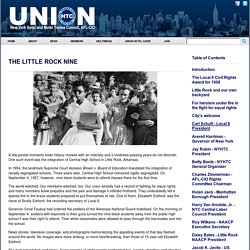
One such event was the integration of Central High School in Little Rock, Arkansas. In 1954, the landmark Supreme Court decision Brown v. Board of Education mandated the integration of racially segregated schools. Neuf de Little Rock. Un article de Wikipédia, l'encyclopédie libre.
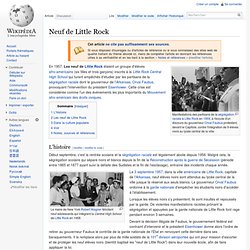
Little Rock Nine. The Little Rock Nine were a group of African American students enrolled in Little Rock Central High School in 1957.
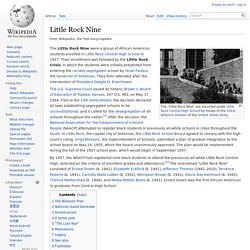
Their enrollment was followed by the Little Rock Crisis, in which the students were initially prevented from entering the racially segregated school by Orval Faubus, the Governor of Arkansas. They then attended after the intervention of President Dwight D. Official Trailer [HD]: The Integration of Little Rock Central Highschool. Etats-Unis. La mixité en échec scolaire. Les Noirs sont au sud, les Blancs au nord : aujourd’hui encore, sur une carte de Little Rock, la capitale de l’Arkansas, il est facile de distinguer les quartiers.

Même Brian Schwieger, guide du musée de Central High School, consacré à la déségrégation raciale, fait le dessin à gros traits : «C’est simple, au nord de l’Interstate 230, vous avez les quartiers blancs et au sud, les Afro-Américains. En ville, on dit même que l’autoroute a été construite, dans les années 60, pour servir de frontière.» En plein cœur de Little Rock, le musée commémore la bataille qui a dû être menée en 1957 pour intégrer les premiers élèves noirs dans ce lycée public, jusqu’alors exclusivement blanc. Il avait fallu déployer l’armée fédérale pour escorter ces neufs lycéens et les protéger des agressions de leurs camarades blancs. L’année suivante, le gouverneur de l’Arkansas avait même préféré fermer tous les lycées publics de la ville plutôt que d’y accepter des Noirs. Les neuf de Little Rock. TV : Little Rock et la ségrégation scolaire aux États-Unis en 1957. Little Rock Nine Documentary.
The Little Rock Nine (2007 Documentary) Integration of Central High School - Black History. In the following weeks, federal judge Richard Davies began legal proceedings against Governor Faubus, and President Dwight D.

Eisenhower attempted to persuade Faubus to remove the National Guard and let the Little Rock Nine enter the school. Judge Davies ordered the Guard removed on September 20, and the Little Rock Police Department took over to maintain order. The police escorted the nine African-American students into the school on September 23, through an angry mob of some 1,000 white protesters gathered outside. 1950 à 1970 - La ségrégation aux États-Unis. A) Les afro-américains dans le système scolaire : En 1954, la NAACP (National Association for the Advancement of Coloured People) remporte une grande victoire devant la Cour suprême, puisqu' elle déclare que la ségrégation scolaire va à l’encontre de la Constitution (arrêt Brown v.

Topeka Board of Education). Décision confirmée par un décret de 1955 de l’administration Eisenhower : « La déségrégation scolaire devait se poursuivre aussi rapidement que possible ». Or, les États du sud se protègent derrière leurs lois locales pour empêcher les adolescents noirs d’étudier dans des écoles blanches. Ainsi, le gouverneur de l’Arkansas, Orval Faubus se range du côté des ségrégationnistes afin de faire obstacle à l’intégration dans les écoles de l’État. Brave Hearts: Remembering the Little Rock Nine, 1957. Civil Rights Movement '50s Beyond religion, beyond class, beyond politics and ideology, for centuries race been the single most contentious, corrosive question in America’s national dialog.
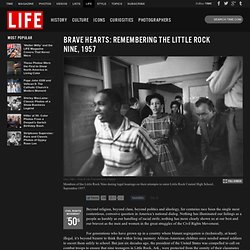
Nothing has illuminated our failings as a people as harshly as our handling of racial strife; nothing has more clearly shown us at our best and our bravest as the men and women in the great struggles of the Civil Rights Movement. For generations who have grown up in a country where blatant segregation is (technically, at least) illegal, it’s beyond bizarre to think that within living memory African-American children once needed armed soldiers to escort them safely to school.
Little Rock Nine - National Historic Site - Arkansas Tourism. Central High In September of 1957, the country was changed forever by the “Crisis at Central High”—one of the first federally ordered integration acts.

At that time, the United States was a nation of racial inequalities and segregation. Decades Later, Desegregation Still On The Docket In Little Rock : Code Switch. Hide captionEight of the nine black students who integrated Little Rock Central High School walk from school to their waiting Army station wagon on Oct. 2, 1957.
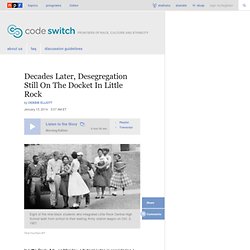
Ferd Kaufman/AP Eight of the nine black students who integrated Little Rock Central High School walk from school to their waiting Army station wagon on Oct. 2, 1957. In Little Rock, Ark., on Monday, a federal judge is considering a deal that would end one of the longest-running and most notorious school desegregation cases in the country. The state, its largest school districts and lawyers representing black students have agreed to settle a complex lawsuit over unequal education. Eisenhower and the Little Rock Crisis. GCSE Bitesize: How much progress has been made by black Americans since the 1960s? Little Rock School Desegregation (1957) Three years after the U.S.

Supreme Court ruled unanimously in Brown v. GCSE Bitesize: Why was it difficult for black Americans to gain equal rights in the USA in the 1950s and 1960s? Little Rock Central High School. The Little Rock Central High School incident of 1957 in Arkansas brought international attention to the civil rights cause. The Montgomery Bus Boycott may have been important but it hardly had media appeal. Here at Little Rock, you had a state fighting against federal authority, national guard troopers facing professional paratroopers and a governor against a president. As part of a media circus, it proved compulsive viewing - but what happened was shown throughout the western world and brought the civil rights issue into the living rooms of many people who may have been unaware of what was going on in the South. Eisenhower had shown that he had little faith in measures to support the African American community in the South simply because he believed that a change of heart was required and that enforcement would not work - if anything, enforcement would make matters worse.
GCSE Bitesize: Why was there so much racial inequality in the USA between 1929 and 1945? Desegregation of Central High School. In its 1954 Brown v. Board of Education of Topeka, Kansas decision, the U.S. Supreme Court ruled that racial segregation in public education was a violation of the Fourteenth Amendment to the Constitution. As school districts across the South sought various ways to respond to the court’s ruling, Little Rock (Pulaski County) Central High School became a national and international symbol of resistance to desegregation. Little Rock Central High School Integration. Home » Events » Little Rock Central High School Integration Background: The desegregation of Central High School in Little Rock, Arkansas, gained national attention on September 3, 1957, when Governor Orval Faubus mobilized the Arkansas National Guard in an effort to prevent nine African American students from integrating the high school.
After several failed attempts to negotiate with Faubus, President Dwight D. Eisenhower took action against the defiant governor by simultaneously federalizing the Arkansas National Guard, removing the Guard from Faubus' control, and ordering one thousand troops from the United States Army 101st Airborne Division in Ft.